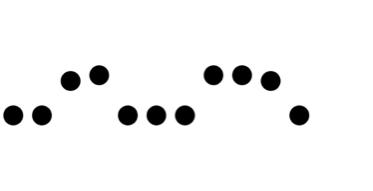MODULE: Gestalt theory
Step 07 of 16: Common fate
The second Law is that of common fate. Essentially, things sharing a common trajectory are grouped together conceptually. This Law has strong associations with movement in particular so is best demonstrated with animation, though it applies equally to even static and unmoving image composition. Take the image below, a line of dots is visible at the bottom and they establish a base "plane" on which all dots seem to sit. The other dots seem to be hovering or have jumped/risen somehow. These risen dots share a "common fate" and so are conceptually grouped as being the dots that jumped, as opposed to the dots that remained grounded.

In moving imagery, all items moving in a similar direction can be considered to have common fate even if they look very different to each other. The above image is static to help establish that even the composition of static items can suggest movement without literally demonstrating it. What is important is that the force imposed upon them, whether external (being nudged) or internal (jumping) gives them visual likeness that we group together rather than computing their individual outcomes.